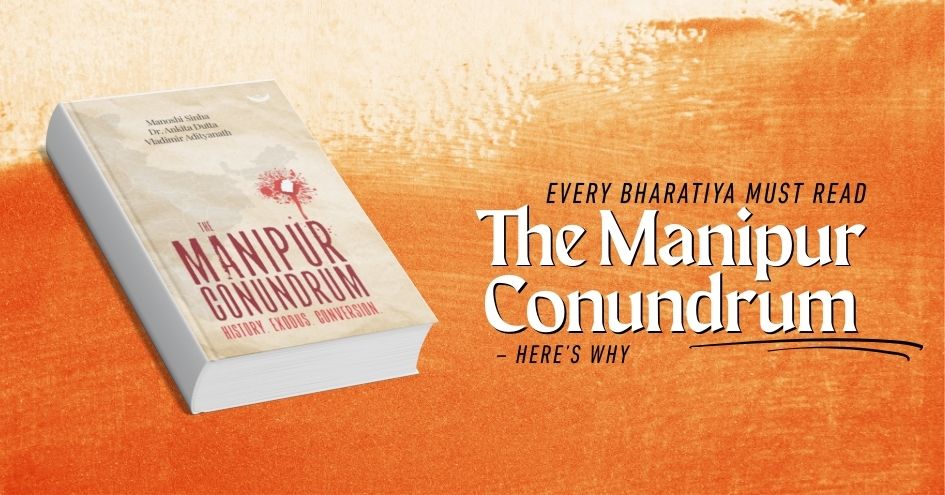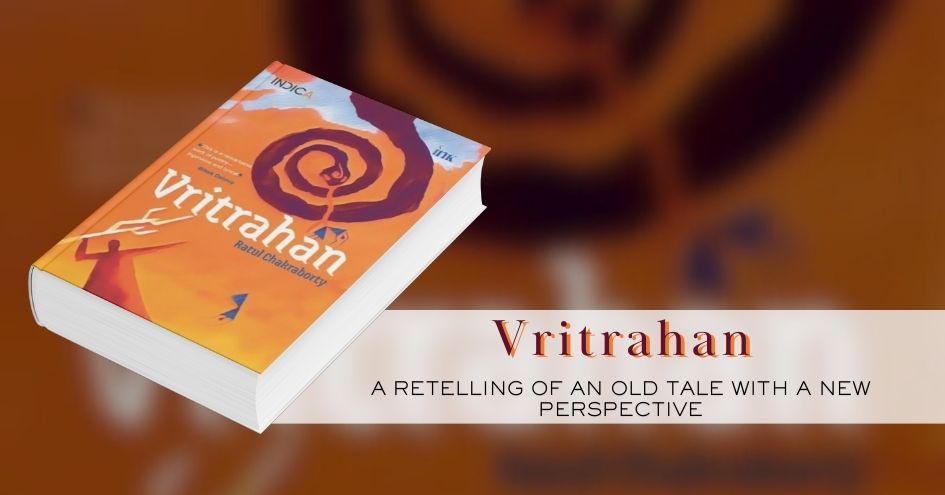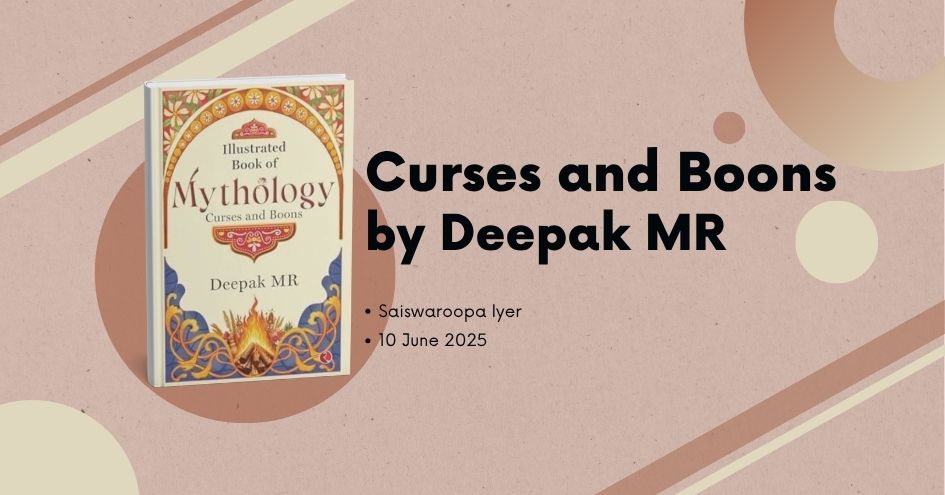
The recently-released book on Manipur titled The Manipur Conundrum – History. Exodus. Conversion. – is the result of tiring efforts by three Bharatiya authors – Manoshi Sinha, historian and author of the bestseller Saffron Swords series, writer and commentator on North-East affairs Dr. Ankita Dutta, and social activist Vladimir Adityanath. In the midst of fake narratives and politically-motivated opinion pieces on the Manipur violence that have been circulating across the media, this book answers it all, authenticated by facts and evidence from both primary and secondary sources. The book is brilliant, a one-of-its-kind, for those who wish to know more about the history of the North-East insurgency and religious conversions. It is divided into three sections, each contributed by the three authors.
The first section, filled with deep historical insights and written by Manoshi Sinha, sets the stage for the rest of the book. It deals with the history and civilization of Manipur since the ancient times and Manipur’s connection with the Mahabharata. To those who disagree with the rich Hindu cultural heritage of Manipur, all that I can request them is to grab a copy of the book immediately and read this section at least. Crisp, factual, and beautifully elaborated it is. As someone who is not very well-acquainted with the society of the North-East, this section of the book enlightened me on the two different sects of the Manipuris – the Meiteis and the Bishnupriyas. It is time now they stop engaging themselves in unnecessary debates on their history/ancestry and rather stay united in the face of the civilizational war that Manipur is witnessing.
The second section has been written by Dr. Ankita Dutta, based on her studies across different states of the North-East over the past several years. We all have heard and read about the brutality of the Islamic and the Portuguese invasions. But, the brutal history of the Burmese invasions in the North-East, has hardly been adequately researched till date. This section of the book begins with a detailed account of the Burmese invasions that would help any objective reader of history connect the dots from then till now. It dwells upon the violence committed by people from Burma at different periods of time in history, focusing on not just Manipur, but the other states of the North-East as well. The post-Independence era has been covered with reference to the loss of the historic Kabaw Valley to Myanmar and its consequences thereof.
Coming to the third section of the book written by Vladimir Adityanath, it lays bare the violence that has marred Manipur since May 3, 2023, leading to the loss of innumerable lives and properties. It is certain to leave a deep impact in the mind of any reader. The fact that the raging conflict has left deep scars on the long-cherished multicultural societal fabric of Manipur has been elaborately covered in this section. The divisive colonial-era administrative and institutional norms and the promulgation, one after another, of short-sighted land laws based on ethnicity in post-colonial India, produced long-term ramifications on the state’s inter-ethnic, demographic and religious equations. Both the second and the third sections of the book must be read in tandem to have a thorough grasp of the complexities of the Manipur violence.
The authors have painstakingly brought to life the story of the genocide of the indigenous people of Manipur since the time of the Burmese invasions – a story that needs to be heard by every Bharatiya. Citing appropriate references, they have explained how the hard-won democratic political stability of post-colonial Manipur was largely jeopardized by factors which were not of its own making. They credibly argue that the Partition of India in 1947, the devaluation of Manipur’s political status, the rise of the military regime in the 1960s (and thereafter) in Burma and the Bangladesh War of 1971 have had their own ethno-demographic and political bearings on not just Manipur but the entire North-Eastern region of Bharat as well.
One gets taken aback given the fact that the prolonged neglect of the growing demographic shift by the successive State and Central Governments and consequential dissensions over the emerging politics centred around the issue of ‘identity’ played its major part, culminating in the violence of May 3. In other words, Manipur was deliberately left susceptible to the adverse spillover effects of political instability in its neighbourhood by our political dispensations. As a result, the exclusive aspirations for separate nationhood of a certain section of the people were increasingly traded off for short-term political gains. Unlike previous books on the North-East insurgency, conflicts across the region have been analysed in the backdrop of an expansionist religious cult that thrives on the politics of binaries, hatred and violence.
One of the standout chapters in the book is the documentation of the different clashes in Assam, Tripura, and Mizoram, at different periods of time in history, eventually leading to the ethnic cleansing of the non-Christian population from these places. These clashes revolve around a similar trajectory that is inherent of an amorphous and expansionist brand of religion-centric identity politics. Powerful insights are offered with respect to the escalation of violence in Manipur since May 3, 2023 that coincided with the rising tide of importing new settler populations from across the border and insidious economic activities such as narco-trade, poppy plantations, small arms proliferation, and human trafficking. The academic inclination, however, has always been to analyse this conflict from the ethnic/tribal lens.
This has failed to provide a healthy understanding of the historical origins of the problem and its subsequent impacts upon the society. It is in this context that The Manipur Conundrum comes in as a breath of fresh air. As the new settler population acquires enormous money and muscle power in society and politics, the age-old fraternal ties among people are either distorted or supplanted by exclusive identity politics in the name of a ‘Greater Homeland’. As someone unaware of such ground realities, the minute facts and details provided in each of the chapters helped me grasp the reasons behind the conflict that has been going on between the indigenous population of Manipur and the ever-expanding population of new settlers since the colonial times.
The writer believes that every Bharatiya and more specifically, every Hindu must read this book and imbibe the lessons from the present situation in Manipur. More so for the reason that its implications are going to be felt for a long time, not just in Manipur but the entire North-East – a region that is extremely crucial from the point of view of our national security. The violence poses an unparalleled threat to the idea of a multicultural Manipur. The ever-increasing socio-political clout of the Church, illegal immigration, the role of Communism, and the problem of narco-terrorism, have been discussed in detail. Also, major issues which are being debated, such as the highly controversial Suspension Of Operations (SoO) Agreement and the actual meaning of a ‘Separate Administration’, etc. have been analysed.
The book takes the reader along on a journey as well, a journey that seeks to trace the origins of the Manipuris till the genesis of the present-day conflict. There are many portions of this book where the narration is too gripping, especially when we try to analyse the authors’ multi-layered arguments in the light of the current crisis in Manipur. Their knack for data-driven research, supplemented with well-documented historical facts and figures, gives a larger picture of the conflict in Manipur. Several pertinent questions are raised in this book with respect to India’s Act-East Policy, and what it means for Manipur and Bharat. A nuanced and balanced understanding is also provided of the systematic destruction of the Sanatan Hindu civilization from the breathtakingly beautiful land of the Loktak.
With an impressive Foreword from Indologist and founder of Chhatrapati Shivaji Maharaj Museum of Indian History in Pune, Francois Gautier, The Manipur Conundrum would make a great gift to anyone interested in learning more about the North-East. The book is a milestone in itself, enlivened further by the assessments provided by politico-religious observer Jerome Anto, former R&AW Officer N.K. Sood, and author and Army personnel Col. Tej Tikoo. Our policymakers, media fraternity, and the general public will definitely benefit from it. A second edition of this book is much awaited that can probably explore the cultural heritage of Manipur in more detail in the backdrop of the different festivals celebrated in the state and the situation there post the imposition of President’s Rule.
Let this book ignite the consciousness of every Hindu. May it serve as a beacon of knowledge for our future generations.
Dharmo Rakshati Rakshitah
 Dakshinamurthy is a scholar and researcher of Indic themes and a contributing writer of The Verandah Club
Dakshinamurthy is a scholar and researcher of Indic themes and a contributing writer of The Verandah Club

Saiswaroopa Iyer is an author who needs no introduction. She is one of the authors who pioneered Puranic fiction in India with books exploring tales f...

Indra killed Vritra using his Vajra. Once again, good won over evil and dharma over adharma. This is a story most Bharatiyas know. The story is a pa...

An engaging dialogue of karma, dharma, and the ancient logic of choice and consequenceIn a literary landscape where Indian Purana Itihasa corpus often...